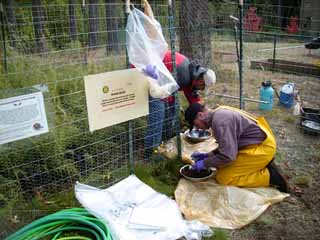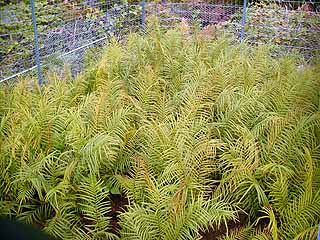
Surveys
DJC.COM
April 27, 2006
Arsenic-eating ferns may clean up Puget Sound soils
Department of Ecology

Photos by Norm Peck/Department of Ecology
Public Health--Seattle and King County employees collect soil samples from a 10-by-10-foot test plot of Chinese brake ferns.
|
"From the dawn of time they come…" will be a familiar phrase if you're a fan of the "Highlander" movie series, full of fantastic swordplay and good overcoming evil. And from the dawn redwood forest in Central China, the Chinese brake fern may emerge as an arsenic fighter in Puget Sound basin soils.
Arsenic is widespread in the central Puget Sound region, resulting from almost a century of air emissions from the former Asarco copper smelter in Ruston that closed in 1986. The majority of the areas affected by contaminants that fell from the smelter's plume have become increasingly urbanized. The growing population of these areas prompts long-term health concerns.
With almost 1,000 square miles affected, the Department of Ecology and local health departments are looking for ways to reduce the potential health risks of that arsenic in the soil. Much of the soil contains arsenic at moderate levels of 20-100 parts per million (ppm). The cleanup standard established by the state's Model Toxics Control Act for arsenic is 20 ppm.
Arsenic-contaminated soil poses a special risk to toddler-age children because they often put things in their mouths, including toys and fingers that are likely to have some dirt on them. Ecology and health departments are focusing on outdoor areas used by children.
A fern like no other
University of Florida researchers identified Chinese brake ferns about four years ago as plants that hyper-accumulate arsenic. That means they take arsenic from the soil and store it in plant tissue, specifically the fern fronds or leaves, at much higher concentrations than in the soil they're grown in.
Using plants to clean up environmental contaminants is called phytoremediation.
When used, it must be done carefully — protecting humans and animals from ingesting the arsenic-storing plants and also safely disposing of the plant fiber in a way that protects people, animals and the environment.
Ecology's study began last year on Vashon-Maury Island and at Point Defiance Park in Tacoma. Ecology found that brake ferns grown in soils containing 25 to 115 ppm arsenic had 800-19,000 ppm arsenic in their fronds after growing from May to October.

Chinese brake ferns were harvested in October 2005 after growing in a locked, fenced plot near Chautauqua Elementary School on Vashon Island.
|
Chinese brake ferns naturally grow in tropical Asian forests. Could they survive our cooler winters and drier summers? Preliminary results suggest the ferns growing in the Puget Sound area do best where there's lots of sun, and they seem to need plenty of water in the summer months to thrive. Brake ferns grown in shady areas were not very vigorous.
The best 100-square-foot plot produced about 18 pounds of fronds. The plants would need a projected six to seven years to remediate the soil in that plot. Another plot had fewer pounds of fronds, but higher arsenic concentrations in the plant tissue. Brake ferns in that plot might remediate the soil in only two or three years.
Could introducing this plant to the area create a new weed? The Chinese brake fern's invasiveness in the southeastern U.S. and Southern California was a caution. Ecology consulted the state Department of Agriculture, which assisted in evaluating the plant's potential invasiveness as part of the test program. So far, these ferns have required considerable care to survive and do not seem likely to pose an invasion threat.
Handle with caution
A "frond-ly" piece of advice: Don't try this at home until we understand more about the arsenic uptake by the plants. All harvested fronds that were tested met the definition of a hazardous waste, and had to be disposed of at a special treatment, storage and disposal facility. There is enough arsenic in a single frond, according to Jim W. White of the state Department of Health, that a child who eats one could become very, very ill, and possibly die.
The test plots are fully fenced (sides and top) and locked to prevent people or animals from getting into them. Warning signs are posted as well, and workers who handle the fronds or soils wear protective clothing (gloves at a minimum) to avoid contact with the arsenic.
| More information |
|
The fern study: www.ecy.wa.gov/programs/ tcp/sites/tacoma_smelter/Phyto/phyto_hp.html
Tacoma smelter plume arsenic contamination: www.ecy.wa.gov/programs/ tcp/sites/tacoma_smelter/ts_hp.htm |
At the conclusion of the study, Ecology will develop recommendations, if appropriate, for use of the brake ferns for phytoremediation. If the plants hold enough promise, it will be important to keep people and animals safe from harm because the ferns will contain much more arsenic than the soil and would be dangerous if ingested.
It will be important to develop a safe and easy way to properly dispose of the arsenic-laden fronds. A few fronds could contaminate a lot of compost, and burning them may release pollutants into the air. Like any powerful tool, they can be dangerous.
The study will run for at least one more year to get more data, and may be extended to see if simple measures like fertilization or increased watering can improve the ferns' efficiency at removing arsenic from soil.
If Chinese brake ferns prove effective — and can be used safely — they could provide an inexpensive way to draw arsenic from soil without the disruption of removing and replacing soil.
Norm Peck is an environmental investigator with the Department of Ecology's Toxic Cleanup Program.
Other Stories:
- Is this as green as Seattle gets?
- Putting a forest floor up on the roof at the zoo
- Program catalogs our fading historic landscapes
- Veterans' cemeteries: an inspiration of place
- Creating an urban forest in Anchorage
- Using GIS as a tool to protect Puget Sound
- Site constrained? That's opportunity knocking
Copyright ©2009 Seattle Daily Journal and DJC.COM.
Comments? Questions? Contact us.